Boscobel House: King Charles II's hiding place back open to visitors after £950,000 revamp
The land where Charles II hid from Oliver Cromwell 370 years ago is back open for visitors after almost £1 million was spent refurbishing the site.

Boscobel House and the Royal Oak on the Staffordshire-Shropshire border has undergone £950,000 worth of improvements - and visitors can once again enjoy the grounds as the site is opened up under the latest easing of lockdown restrictions.
Boscobel House was a hiding place for persecuted Catholics during the Civil War and Charles II famously taking took from Oliver Cromwell’s armies after defeat at the Battle of Worcester in 1651 by hiding in an oak tree, before spending the night in the house’s priest hole.
The house, first built in 1632 as a timber-framed farmhouse, was converted into a hunting lodge by John Giffard of Whiteladies and eventually was home to a working farm in the 19th century.


English Heritage, which owns and runs the site, hopes the recent work will allow the attraction to look and feel as it would have done almost 170 years ago as a thriving Victorian farm.
Rare and local breed animals, including Tamworth pigs and Ryeland sheep, have been introduced to the farmyard, while the inside of the building has been refurbished to feature an interactive tour. However the indoor parts of the site will not be opening for another six weeks.
Liz Page, territory director for the West at English Heritage, said: “Boscobel is a unique site. It is a Civil War gem, vividly depicting one of the most iconic stories in English history.
"However, it later became a working farm after Charles II’s escapades and, as such, retains an extraordinary collection of Victorian farm buildings and machinery.


“This fantastic investment has enabled us to breath life into both of these important stages in Boscobel’s history, with visitors able to explore the lodge, farmyard and gardens, as well as see a descendant of the Royal Oak in which the future king hid.
"There’s lots for families too, with the introduction of farmyard animals, a fun willow tunnel and an exciting new play area before the chance to enjoy refreshments in the refurbished tea room.”
The woodland which once surrounded the Royal Oak has been replanted, using saplings propagated from the original, as it is slowly restored to how it looked when Charles II hid there in the 17th century.

A new “hide and seek” area, a willow tunnel and grass maze have been created – having been designed by Davies White Landscape Architects – to help children reconnect with nature, with the theme extending indoors where visitors can explore the secret priest holes.
The 17th Century gardens, where Charles II is said to have relaxed after the soldiers departed, has been created and an orchard has been re-integrated into the grounds on the site.
Another improvement includes ramped facilities such as a new and improved cafe offering, shop and toilets.
Visitor facilities at Boscobel House and the Royal Oak were opening today, with the interior of the house opening on May 27.





